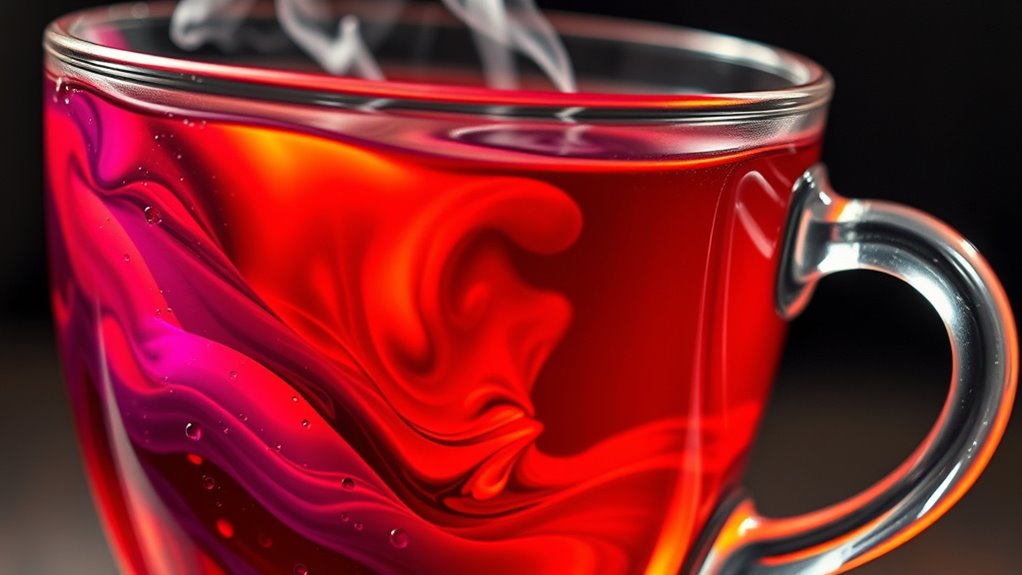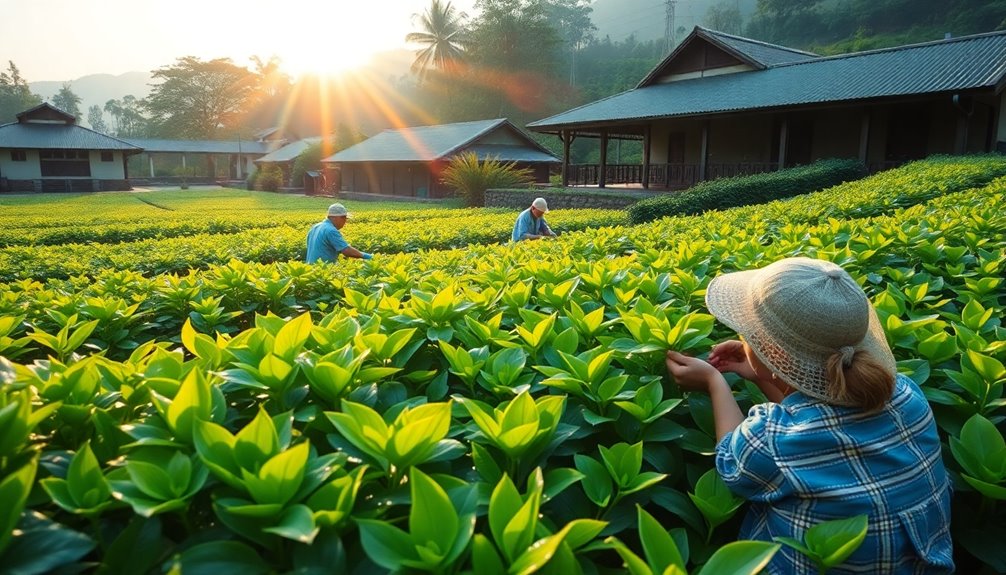Polyphenols in tea, mainly catechins and flavonoids, play a central role in its color transformation. During processing, enzymes oxidize these compounds when exposed to air, producing molecules like theaflavins and thearubigins that deepen the color from green to dark brown. The level of oxidation affects the hue and brightness of your brew, with more oxidation resulting in darker shades. Understanding this process helps explain how tea’s vibrant or rich colors develop—if you want to explore more, keep going.
Key Takeaways
- Polyphenols like catechins determine the initial green color of fresh tea leaves.
- Oxidation converts polyphenols into darker compounds such as theaflavins and thearubigins, deepening tea color.
- The degree of polyphenol oxidation influences whether the tea appears green, amber, or dark brown.
- Polyphenol derivatives reflect light differently, affecting the brightness and hue of the brewed tea.
- Processing conditions impact polyphenol stability, thereby controlling the final color transformation of the tea.

Polyphenols, naturally occurring compounds found in tea leaves, play a significant role in determining the beverage’s color. These compounds, mainly catechins and flavonoids, are sensitive to various processing steps that influence how the tea looks when brewed. One essential factor is the oxidation process, which occurs during fermentation or oxidation stages. When tea leaves are exposed to air, enzymes catalyze the oxidation of polyphenols, transforming their structure and leading to the development of darker hues in black and oolong teas. This oxidation not only deepens the color but also alters the chemical composition, impacting flavor and aroma as well. Understanding oxidation is crucial for appreciating how different tea types achieve their unique colors.
Polyphenol oxidation deepens tea color, transforming flavor and aroma during processing.
As polyphenols undergo oxidation, their interaction with other compounds influences the final color of the tea. For example, the oxidation of catechins results in the formation of theaflavins and thearubigins, which are responsible for the bright amber and reddish-brown colors typical of black teas. These polyphenol derivatives are larger molecules that reflect light differently, giving the brew its characteristic hue. The degree of oxidation directly correlates with the intensity of the color; lightly oxidized teas like green tea retain more of the original greenish tones, while heavily oxidized teas tend toward darker shades.
Another key aspect is anthocyanin stability, which plays an important role in color development, especially in teas that undergo partial oxidation or special processing methods. Anthocyanins are naturally vibrant pigments found in various plants, and their stability is influenced by pH, temperature, and oxidation conditions. During tea processing, especially in certain traditional methods, the stability of anthocyanins determines how well the color holds or changes over time. When anthocyanins are stable, they contribute to the reddish or purple hues seen in some specialty teas, adding complexity to the beverage’s appearance. Conversely, if the oxidation process destabilizes these pigments, the color can fade or shift, affecting the visual appeal.
In essence, your tea’s color results from a delicate balance between the oxidation process and the stability of anthocyanins and other polyphenols. By controlling oxidation levels during processing, tea producers can influence the final color, from vibrant green to deep brown or reddish shades. The chemistry behind these transformations highlights how polyphenols are not just flavor contributors but also key in defining the visual aspect of your tea. Understanding this interplay helps you appreciate how the intricate processes shape the beautiful spectrum of tea colors you enjoy, making each cup a unique reflection of its chemical journey.
Frequently Asked Questions
How Do Polyphenol Levels Vary Across Different Tea Types?
You’ll notice that polyphenol content varies across different tea types. Green teas generally have higher polyphenol levels because they undergo minimal oxidation, preserving these compounds. Black and oolong teas experience more tea oxidation, which reduces polyphenol levels while creating new flavonoids. White teas have moderate polyphenol content, as they’re lightly processed. This variation influences not only health benefits but also the tea’s color and flavor profile.
What Role Does Brewing Temperature Play in Tea Color Change?
Brewing temperature is like the dial of a painter’s palette, shaping your tea’s final hue. Higher temperatures boost extraction efficiency, releasing more polyphenols that deepen the color. But go too hot, and you risk over-extraction, making the tea bitter. Moderate temperatures balance flavor and color, giving you a vivid, appealing brew. So, adjusting temperature carefully directly influences how vibrant or muted your tea’s appearance becomes.
Can Polyphenols Affect the Flavor Profile Alongside Color?
Polyphenols do influence tea’s flavor profile, alongside color, by contributing to flavor development and aroma enhancement. As you brew, polyphenols interact with other compounds, creating complex tastes and inviting fragrances. These compounds can add astringency and depth, enriching your tea experience. So, when you explore different brewing methods, you’re not just changing color but also shaping the aroma and flavor, making each cup uniquely satisfying.
Are There Health Benefits Linked to the Color Changes in Tea?
You might wonder if color changes in tea have health benefits. As the tea darkens, it’s often linked to increased antioxidant benefits, which help protect your cells. These antioxidants also support heart health by reducing inflammation and improving blood flow. So, when your tea shifts in color, it’s not just visually appealing; it could also be contributing to your overall well-being through these health benefits.
How Does Storage Impact Polyphenol Content and Tea Color?
They say “a stitch in time saves nine,” and that’s true for tea storage. When you store tea improperly, polyphenol degradation speeds up, which dulls its vibrant color and weakens flavor. Keep your tea in airtight containers, away from sunlight and heat, to preserve polyphenols and maintain the rich, appealing color. Proper storage guarantees your tea stays fresh, flavorful, and visually appealing longer.
Conclusion
Ever wondered how those vibrant tea colors develop right before your eyes? By understanding how polyphenols oxidize and interact, you can appreciate the beautiful transformation from green to amber or deep brown. This process isn’t just about appearance—it’s about flavor, aroma, and your overall experience. So next time you brew a cup, ask yourself: wouldn’t you want to savor not just the taste, but the fascinating science behind its color?










